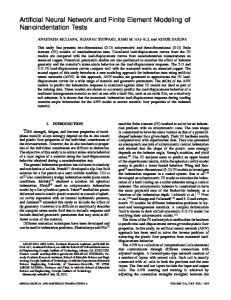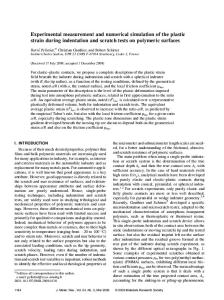Finite element modeling and simulations on indentation and scratch tests on thin films: effects of prestress
- PDF / 1,899,633 Bytes
- 8 Pages / 612 x 792 pts (letter) Page_size
- 73 Downloads / 326 Views
esearch Letter
Finite element modeling and simulations on indentation and scratch tests on thin films: effects of prestress Biao Feng and Zhen Liu, Theoretical Division, Los Alamos National Laboratory, Los Alamos, NM 87545, USA Address all correspondence to Zhen Liu at [email protected] (Received 22 March 2019; accepted 26 April 2019)
Abstract Indentation and scratch models are proposed to numerically investigate effects of compressive prestress on film’s mechanical responses. In indentation, normal stress distributions are strongly dependent on film thickness; the applied force and the maximum normal stresses with a prestress are much larger than without prestress. For various film thicknesses the change in the normal force in scratch between the nonprestressed and prestressed films is 4%–23%. The scratch friction coefficient is larger with prestress than without prestress. With biaxial or uniaxial prestress the material becomes more difficult to deform or to slide at the contact surface compared with cases without prestress.
Introduction Surface coating has been attracting researchers’ attention by improving material properties and performances without changing bulk materials.[1–9] The tribological and compression performance of a coating in many cases determines material applications in practice, since it plays an important role in surface fracture, wear, friction, fatigue, material lifetime, etc.[10–12] There has been an increasing interest in studying compression and tribology performance of coatings both in the scientific community and in industry, and the indentation and scratch tests become widely-used tools in this research process. The full fields of material deformations and stresses in the coatings during indentation and scratch are very complex and unable to be determined experimentally due to the nonlinearity caused by multi-physics involved in the tests (e.g., large elastoplasticity, cracking, fracture, and wear) and the nonlinearity in geometry of a contact surface due to severe plastic deformation. The finite element method (FEM) serves as a powerful tool to reveal the detailed mechanical responses in the scratch and indentation processes. Pioneering FEM simulations on indentation and scratch tests, based on classic elastoplasticity, have been successful in both interpret experimental phenomena and help optimize designs.[10–22] Residual stresses commonly exist in engineering structures and parts due to thermal mismatch or mechanical/thermal processing, and they have significant effects on the mechanical behavior of materials, such as plasticity, fatigue, fracture, corrosion, wear, and friction.[23] In particular, when surface coating has different properties from bulk materials, the residual stresses can easily appear during manufacturing and assembling due to temperature changes, or in service. In many cases the residual stresses are complexly distributed in the materials,
756 ▪
which makes a quantitative study challenging. Therefore, it is common to apply a homogeneous prestress field in materials to study
Data Loading...











